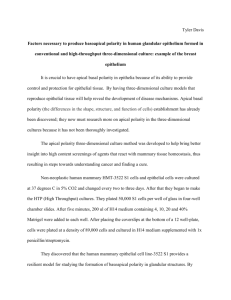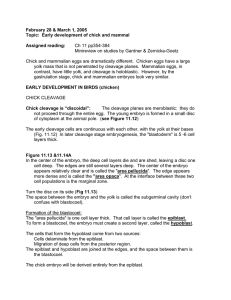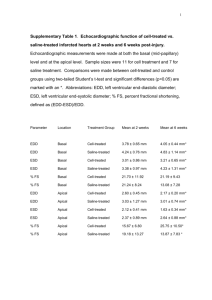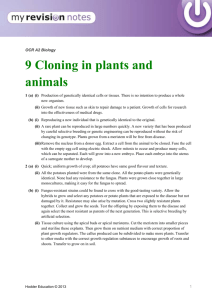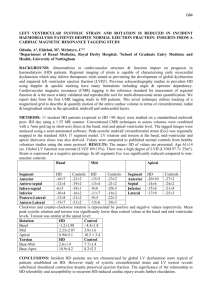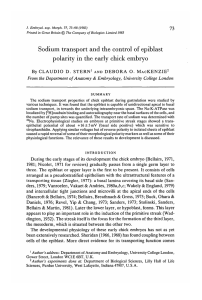468 Preliminary notes
advertisement
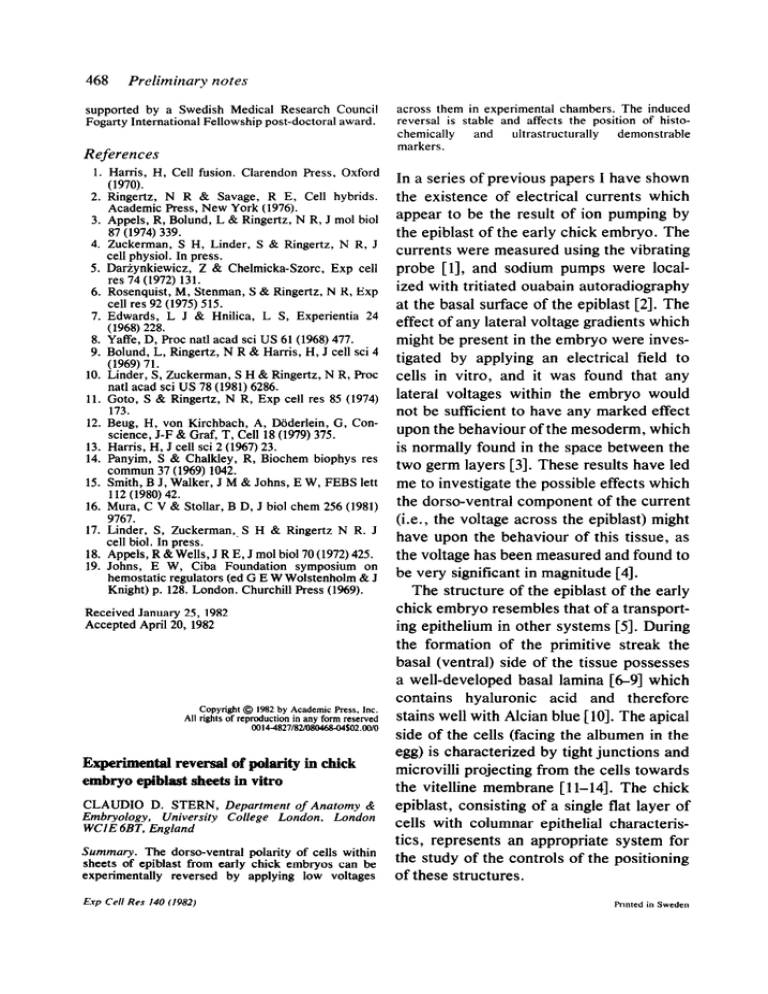
468 Preliminary notes supported by a Swedish Medical Research Council Fogarty International Fellowship post-doctoral award. References 1. Harris, H, Cell fusion. Clarendon Press, Oxford (1970). 2. Ring&z, N R & Savage, R E, Cell hybrids. Academic Press. New York (1976). 3. Appels, R, Bolund, L & Ringertz; N R, J mol biol 87 (1974) 339. 4. Zuckerman, S H, Linder, S & Ringer& N R, J cell physiol. In press. 5. Darzynkiewicz, Z & Chelmicka-Szorc, Exp cell res 74(1972) 131. 6. Rosenquist, M, Stenman, S & Ringertz, N R, Exp cell res 92 (1975) 515. 7. Edwards, L J & Hnilica, L S, Experientia 24 (1968) 228. 8. Yaffe, D, Proc natl acad sci US 61(1968) 477. 9. Bolund, L, Ringertz, N R & Harris, H, J cell sci 4 (1969) 71. 10. Linder, S, Zuckerman, S H & Ringertz, N R, Proc natl acad sci US 78 (1981) 6286. 11. Goto, S & Ringertz, N R, Exp cell res 85 (1974) 173. 12. Beug, H, von Kirchbach, A, Diiderlein, G, Conscience, J-F & Graf, T, Cell 18 (1979) 375. 13. Harris, H, J cell sci 2 (1%7) 23. 14. Panyim, S & Chalkley, R, Biochem biophys res commun 37 (1969) 1042. 15. Smith, B J, Walker, J M & Johns, E W, FEBS lett 112 (1980) 42. 16. Mura, C V & Stellar, B D, J biol them 256 (1981) 9767. 17. Linder, S, Zuckerman,.S H & Ringertz N R. J cell biol. In press. 18. Appels, R&Wells, J R E, J mol biol70 (1972) 425. 19. Johns, E W, Ciba Foundation symposium on hemostatic regulators (ed G E W Wolstenholm & J Knight) p. 128. London. Churchill Press (1%9). Received January 25, 1982 Accepted April 20, 1982 Copyright @I 1982 by Academic Press, Inc. All rights of reproduction in any form reserved 0014-4827/8-$02.00/0 Experimental reversal of polarity in chick embryo epiblast sheets in vitro CLAUDIO D. STERN, Department of Anatomy & Embryology, University College London, London WCIE 6BT. England Summary. The dorso-ventral polarity of cells within sheets of epiblast from early chick embryos can be experimentally reversed by applying low voltages Exp Cell RPS140 (1982) across them in experimental chambers. The induced reversal is stable and affects the position of histochemically and ultrastructurally demonstrable markers. In a series of previous papers I have shown the existence of electrical currents which appear to be the result of ion pumping by the epiblast of the early chick embryo. The currents were measured using the vibrating probe [l], and sodium pumps were localized with tritiated ouabain autoradiography at the basal surface of the epiblast [2]. The effect of any lateral voltage gradients which might be present in the embryo were investigated by applying an electrical field to cells in vitro, and it was found that any lateral voltages within the embryo would not be sufficient to have any marked effect upon the behaviour of the mesoderm, which is normally found in the space between the two germ layers [3]. These results have led me to investigate the possible effects which the dorso-ventral component of the current (i.e., the voltage across the epiblast) might have upon the behaviour of this tissue, as the voltage has been measured and found to be very significant in magnitude [4]. The structure of the epiblast of the early chick embryo resembles that of a transporting epithelium in other systems [5]. During the formation of the primitive streak the basal (ventral) side of the tissue possesses a well-developed basal lamina [&9] which contains hvaluronic acid and therefore . stains well with Alcian blue [lo]. The apical side of the cells (facing the albumen in the egg) is characterized by tight junctions and microvilli projecting from the cells towards the vitelline membrane [ll-141. The chick epiblast, consisting of a single flat layer of cells with columnar epithelial characteristics, represents an appropriate system for the study of the controls of the positioning of these structures. Prmted in Sweden Preliminary notes 469 Materials and Method In the present experiments, chick embryos at preprimitive streak or early streak stages were deprived of their hypoblasts using tungsten needles, and mounted on their own vitelline membranes in the chambers as shown in fig. 1. In these chambers the embryos could be mounted either way up. The ap paratus containing the tissue was placed in a 3PC incubator and a voltage of NO mV was applied to the electrodes by a simple clamp device [3] for up to 6 h. The resistance across the sheets was constantly monitoted by measuring the current flow. After the desired period of incubation the epiblasts were fixed in buffered formal saiine with 0.5% cetylnvridinium chlo- .ride for histochemistry with Alcian blue [IO]. Ahematively, they were fixed in 40 mM sodium cacodylate buffer at pH 7.4 containing 2% paraformaldehyde and 2.5 % glutaraldehyde for transmission electron microscopy (TEM), using a Philips EM300 electron microscope. Results and Discussion Embryos stimulated for up to 30 min with voltages up to 30 mV (apical side positive) were identical with control embryos (fig. 2a) in terms of the intensity or the location of the basal lamina as stained with Alcian blue. Embryos which were stimulated for over 45 min with between 15 and 30 mV now showed some staining of the apical side of the epiblast cells. By 60-90 min stimulation all the Alcian blue positivity was found at the apical surface of the cells (fig. 2b). This newly positioned material could not be demonstrated if the sections were incubated with testicular hyaluronidase. Epiblasts stimulated for 3 h or longer with 20-30 mV also showed Alcian blue positivity only at the apical surface of the cells, and this characteristic was retained in the absence of any further stimulation if the epiblasts were allowed to remain at 37°C in the chambers for at least 12 h. The resistance of the epiblast sheets was 2.0f 1.l KfIcm2 at the start of the experiments. By 30-45 min it dropped to 0.6kO.4 k&m2 and by 60-90 min it had usually returned to the starting value. One possible interpretation of this is that the continuity of the sheet was disrupted, perhaps by dis- Fig. f. Diagram of the experimental setup. The vitelline membrane (V) with the epiblast (E) attached was stretched around a glass ring (R) which was then waxed onto a glass microscope slide (5) with a 2.5 mm diameter hole cut out. A glass tube (T) was waxed into nosition inside the rina and orovided with l-2.5 ml medium (Pannett-Comp?on sahne or medium 199 with or without 10% FCS). In a few cases a Millinore filter was placed between the membrane and the glass slide. The assembly was placed over a pool of medium in a shallow dish (M) and two Ag-AgCI probes (A) connected to the voltage clamp (C) were placed as shown. assembly of intercellular junctions, and reestablished upon further stimulation. Epiblasts clamped at 15-20 mV for 3 h with the same polarity of the applied voltage as in the embryo (i.e., basal side positive) were identical with control embryos which had not been stimulated. Epiblasts clamped at 20-30 mV for the same period of time and the same polarity (as in the embryo), however, showed little or no Alcian blue positivity. The use of long (20 cm each) agar bridges between the electrodes and the culture medium did not prevent the changes described above, thus ruling out an effect of electrode products. When the epiblasts were stimulated for 2-3 h at 4°C no change in the location of the Alcian blue positivity was found with respect to the controls. This indicates that electrophoresis of hyaluronic acid is not solely responsible for the reversal of the location of the positivity. However, in 2 cases where epiblasts were stimulated with 25 mV at 4°C for 3 h, and then placed at 3PC in the absence of an applied F-VP Cell Res 140 11982) 470 Preliminary notes Fig. 2. Alcian blue staining localization in sections of epiblast. (a) Control epiblast placed in the setup for 3 h without stimulation. Note the Aician blue positivity (arrows) at the basal surface of the tissue, away from the vitelline membrane (V). (b) Eniblast stimulated for 2.5 h with 25 mV (apicaiside &i&e). The Alcian blue positivity is clearly located only at the apical side, towards the vitelline membrane (V). Fig. 3. TEM of a stimulated epiblast specimen, basal side of the tissue. 25 mV had been applied for 2.5 h, apical side positive. Note the long intercellular junctions (arrow.s) at the basal side and the large number of mitochondria. x23000. voltage for another 3 h, Alcian blue positivity was found at the apical surface of the tissue. This indicates that whilst the establishment of a new polarity can be induced with little or no energy expenditure by the cells, the expression of this polarity in terms of the location of the Aician bluepositive material does require metabolic energy. These observations suggest that the sodium pumps themselves, normally located near the basal surface of the cells, might be electrophoresed to the apical side in the stimulated specimens in a similar manner to that proposed by Jaffe and his co-workers [ 15, 16], for other molecufes in the plasma membrane. This may also explain why the reversal of the polarity shown by specimens stimulated for over 3 h is stable, as once the pumps are found in the new location, the tissue woufd act as if under clamp by the electrogenic pumps rather than by the electrodes. The possibility that the sodium pumps themselves may be electrophoresed by the applied voltage is currently under investigation in this Laboratory. A fuller study of the role of the sodium pumps is also in preparation. ErpCellRrs140 (1982) Preliminary notes When sections of epiblasts stimulated with 25 mV (apical side positive) for 2.5 h were. observed by TEM, the cells were found to contain more mitochondria than control cells, particularly at their basal side (fig. 3). There was also a noticeable increase in the amount of rough endoplasmic reticulum. Intercellular junctions (probably tight junctions) were now found at both the apical and basal cell-cell borders. This is in striking contrast to the controls where they could only be found in the apical regions. Junctions at the basal side of stimulated epiblast cells tended to be longer and more prominent than those at the apical side of the same cells. Light microscopical observation of semithin plastic sections of the same specimens revealed that the nuclei of stimulated specimens tended to lie in the centre or near the apical side of the cells, whilst in control epiblasts the nuclei were placed more frequently towards the basal side of the cells. The results presented here demonstrate that it is possible to induce a reversal of dorso-ventral polarity in cells of the epiblast of the early chick embryo, by applying voltages of the same order as those found in ovo [ 1, 41, but of reverse polarity with respect to measured trans-epiblast voltages. These results also suggest that it is this transepithelial component of the measured currents which is important in the control of early development. I would like to thank the Cancer Research Campaign and the Science Research Council for financial support in the form of grants to Professor Ruth Bellairs, to whom I am grateful for her advice and encouragement. I am also grateful to Mrs R. Cleevely for technical assistance and to Professor L. F. Jaffe and Drs A. E. Warner and R. J. Zalin for their suggestions and criticisms. References 1. Jaffe, L F L Stern, C D, Science 206 (1979) 569. 2. Stern, C D. J Anat 134 (1982) 606. Prmted ,n Sweden 471 3. Stem, C D, Exp cell res 136 (1981) 343. 4. MacKenzie, D 0, Thesis, Purdue University (1980). 5. Berridge, M & Oschman, J, Transporting epithelia. Academic Press, New York (1972). 6. Sanders, E J, Cell tiss res 198 (1979) 527. 7. Wakely, J & England. M A. Proc rov sot Lond B 206 (1979) 329. 8. Vanroelen, C, Vakaet, L & Andries, L, Anat embryol 159 (1980) 361. 9. - J embryo1 exp morph01 56 (1980) 169. 10. - Anat embryo1 160 (1980) 361. 11. Revel, J P, Yip, P & Chang, L L, Develop biol 35 (1973) 302. 12. Sanders, E J, Z Zellforsch 141 (1973) 459. 13. Bellairs, R, Sanders, E J & Portch; P A, Zoon 6 (1978) 39. 14. Bancroft, M & Bellairs, R, Cell tiss res 155 (1974) 399. 15. Jaffe, L F, Nature 265 (1977) 600. 16. Poo, M-m & Robinson, K R, Nature 265 (1977) 602. Received January 29, 1982 Accepted March 31, 1982 Copyright @ 1982 by Academic Press, Inc. All ngbts of reproduction m any form reserved 0014-4827/82/080471~$02.0010 Cilia regeneration in Tetrahymena. A simple reproducible method for producing large numbers of regenerating cells FRANK J. CALZONE and MARTIN A. GOROVSKY, Department of Biology, University of Rochester, Rochester, NY 14627, USA Summary. We have developed an improved medium in which Tetrahvmena can be deciliated bv gentle shear- ing. The cells~remain viable and regenerate a new complement of cilia. Unlike previous methods for viable beciliation of Tetrahymina, this method is easily adaptable to large numbers of cells, to cells in different stages of the life cycle (growing, starved, coniuaating), and to both commonlv studied snecies. T. ih;rmophila and T. pyriformis. Starved T. thkmophila deciliated bv this method regained motilitv bv 1 h. regenerated-oral apparatus by>.0 h and restored tubui lin in cilia at a linear rate of about 3 pg h-’ cell-‘. A method for deciliating growing Tetrahymena which leaves cells viable and able to regenerate cilia was first developed by Rosenbaum & Carlson [I]. This method was modified by Guttman & Gorovsky [2] to apply to cells starved for a long period, al-
